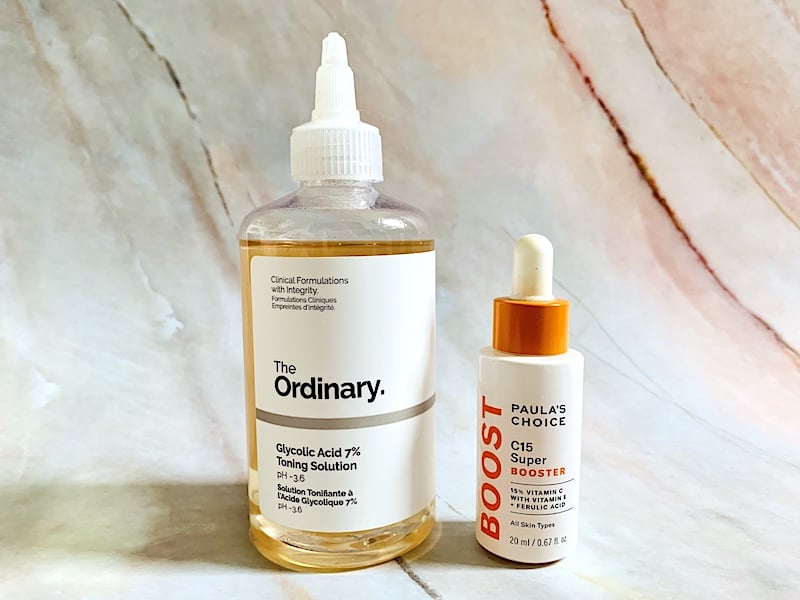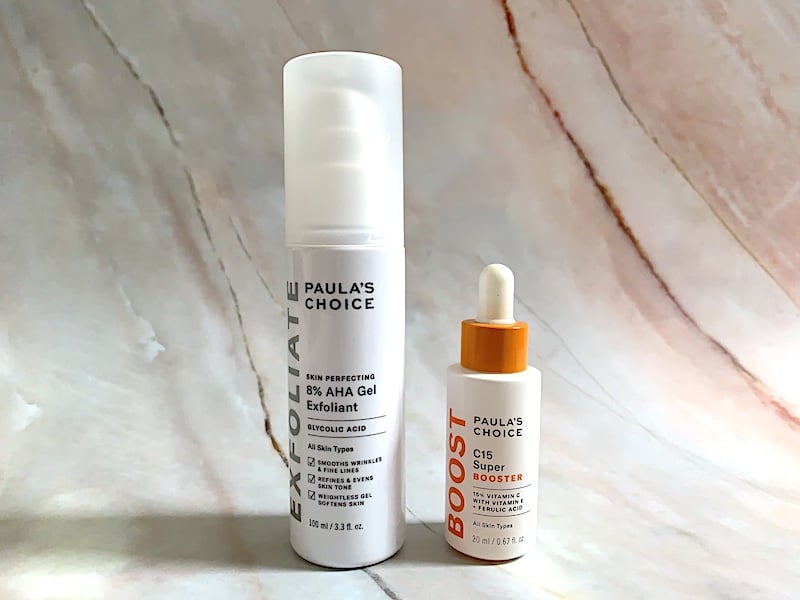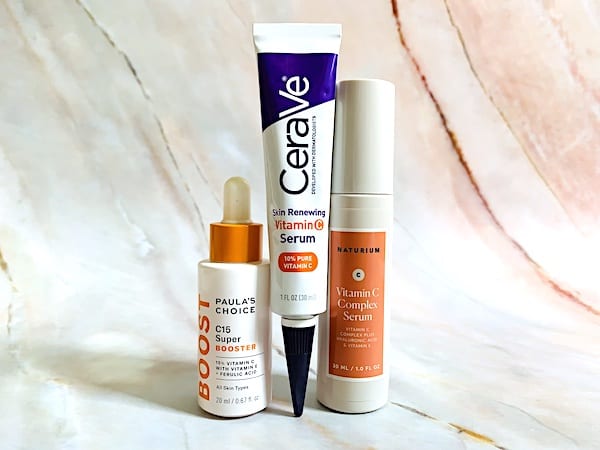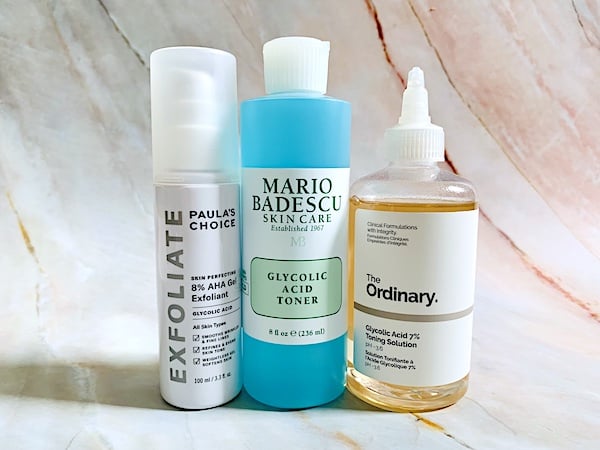Can I Use Glycolic Acid And Vitamin C
Glycolic acid and vitamin C (ascorbic acid/l-ascorbic acid) are over-the-counter actives that you can use to address the visible signs of aging like wrinkles, fine lines, dullness, uneven skin tone, hyperpigmentation, and loss of elasticity.

So since they are such effective anti-agers, can you use glycolic acid and vitamin C together? It depends on the pH of the products and your skin type.
This post contains affiliate links, and any purchases made through these links will result in a commission for me at no extra cost to you. Please read my Disclosure for additional information.
Can You use Glycolic Acid and vitamin C Together?
Technically you can use glycolic acid and vitamin C together, but you may get better results by using them separately. This reasoning is due to the chemical makeup of these two actives. The pH of glycolic acid is typically between 3.0 and 4.0. Optimal pH levels of vitamin C are 3.5 or under . For reference, normal skin has a pH of around 5.0 – 5.5, so these actives reduce your skin's pH to do their exfoliating work.
The fact that the pH range of glycolic acid and ascorbic acid is in a similar range is good news. It means that they can both be absorbed by the skin and be effective even when used at the same time.

The reason why you want to avoid using glycolic acid and pure vitamin C at the same time comes down to tolerance and how your skin reacts. Glycolic acid is the smallest of all alpha hydroxy acids, so it can get deeper into the skin, which may cause redness and irritation upon application.
Vitamin C is also acidic and may cause irritation, burning, stinging, and redness depending on the concentration. So combining the two is a recipe for irritation and redness.
If your skin is not sensitive and can withstand harsh exfoliating acids and low acidic products, you might be able to use glycolic acid and vitamin C together, but why not play it safe and use them at different times of the day?
For example, you may be tempted to combine best-selling glycolic products like Pixi Glow Tonic with a vitamin C serum or an exfoliating liquid like Pixi's Vitamin-C Tonic, but since Pixi Glow Tonic contains 5% glycolic acid and their Vitamin-C Tonic contains pure ascorbic acid, it is best to use them at different times of the day or alternate them on different days.
Related Post: Pixi Skincare Review
Using Vitamin C Derivatives and Glycolic Acid At The Same Time
What about using vitamin C derivatives and glycolic acid together? Luckily, there are several vitamin C derivatives to choose from that are formulated to provide many of the same benefits as ascorbic acid but are more stable and do not irritate the skin. The conversation returns to pH when determining if these vitamin C derivatives can be used with glycolic acid.
Glycolic acid has been shown to absorb better at a pH of 3.0 compared to a higher 7.0 pH.
What about the pH of vitamin C derivatives? There are several vitamin c derivatives available on the market today, and their pHs are higher than pure vitamin C and tend to range between 4.0 and 7.0.
Using glycolic acid products at a pH of between 3.0 and 4.0 (for optimal effectiveness) and a vitamin C derivative of over 4.0 may reduce the effectiveness of both products. So if this is the case, you might consider applying your glycolic acid product first and waiting for it to absorb 30 minutes before applying a vitamin C derivative or simply use them at different times of the day.
Whether you are using pure vitamin C or a vitamin C derivative, consider applying vitamin C in your morning skincare routine to provide antioxidant protection while your skin is exposed to the sun and environmental stressors during the day. Another benefit of using pure vitamin C products during the day is that ascorbic acid can also boost the sun-protective benefits of sunscreen .
Save glycolic acid for the evening when you can follow it with soothing and moisturizing actives like hyaluronic acid and niacinamide and rich moisturizers that work to replenish your skin overnight.
The Benefits of Vitamin C
Vitamin C in the form of pure ascorbic acid (also called l-ascorbic acid) is up there with anti-aging superstar retinol when it comes to all that it can do for the skin. Vitamin C has three main anti-aging benefits for the skin:
- Vitamin C is a potent antioxidant that protects the skin from UV exposure and cell-damaging free radicals.
- Vitamin C stimulates collagen production. Collagen helps the skin stay firm and smooth, while fighting wrinkles, fine lines, and loss of elasticity. Pure vitamin C has been shown to improve wrinkles, roughness, and skin tone on photodamaged skin .
- Vitamin C is a skin brightener and helps to decrease hyperpigmentation, dark spots, age spots, sun spots, and uneven skin tone. It inhibits the enzyme tyrosinase that is involved in the production of melanin (the pigment in our skin).
With these wonderful benefits, there are some drawbacks to pure vitamin C (ascorbic acid). Pure vitamin C is unstable, and it will oxidize when it encounters air, heat, and light, so its shelf life tends to be short.
Ascorbic acid may also be irritating to the skin, depending on the concentration. Some, especially those with sensitive skin, may not be able to use pure vitamin C due to redness, stinging, and irritation. Try to stick to ascorbic acid concentrations of 15% or less.
Vitamin C Picks

Paula's Choice BOOST C15 Super Booster

Paula's Choice BOOST C15 Super Booster is formulated with an effective 15% concentration of pure ascorbic acid at a pH of 3.0 in a lightweight, almost water-like consistency. It also contains vitamin E and ferulic acid for better stability and efficacy. It is easily mixed with other serums or moisturizers or can be used alone.
CeraVe Skin Renewing Vitamin C Serum

CeraVe Skin Renewing Vitamin C Serum is a best-selling drugstore vitamin C serum that contains 10% pure vitamin C, three essential ceramides, moisturizing hyaluronic acid, and soothing vitamin B5, all at an affordable price.
Naturium Vitamin C Complex Serum

Naturium Vitamin C Complex Serum contains pure vitamin C in the form of l-ascorbic acid plus a vitamin C derivative (sodium ascorbyl phosphate) and a bioactive fruit blend to brighten the skin and provide antioxidant protection.
Related Post: Can You Use Niacinamide with Vitamin C? , The Best Korean Vitamin C Serums
The Benefits of Glycolic Acid
Glycolic acid is an alpha hydroxy acid (AHA) that exfoliates dead skin cells on the skin's surface to reveal a brighter and fresher complexion with improved clarity.
- Glycolic acid is an all-star anti-ager, as it helps decrease the appearance of fine lines, wrinkles, and dullness.
- Glycolic acid helps fade hyperpigmentation, dark spots, and uneven skin tone and texture.
- Glycolic acid increases collagen synthesis over time, which helps to improve skin firmness and elasticity.
- Glycolic acid can also thicken the skin for a plumper, more youthful-looking complexion.
Depending on the concentration, glycolic acid is one of the few over-the-counter skincare products that provides noticeable results overnight. The result is a brighter complexion, with a smoother, more radiant skin tone and texture.
Glycolic acid is a great choice for congested, oily, and acne-prone skin as it helps to fade acne scars and clear away pore-clogging dead skin cells.
Derived from sugar cane, glycolic acid has the smallest molecule size of all AHAs, which means that it can reach deeper into the upper surface layers of your skin than other AHAs like lactic acid or mandelic acid .
Due to this ability to absorb deeper into the skin than other AHAs, glycolic acid may cause irritation, stinging, burning, and redness depending on your skin type, glycolic acid pH, and glycolic acid concentration.
Regardless of what level of glycolic acid concentration you use on your skin, glycolic acid makes your skin more sensitive to the sun. So be sure to use a broad-spectrum sunscreen with an SPF of at least 30 while using glycolic acid or other AHAs and for a week after.
Glycolic Acid and Sensitive Skin
If you have sensitive skin, you may consider forgoing glycolic acid altogether and choose a gentler acid with a larger molecule size, such as lactic acid or mandelic acid. You can also look for products that contain fruit acids like malic acid or citric acid, which are even gentler on the skin. These acids will provide a mild exfoliation but still resurface the skin and improve skin texture and tone with continued use.
Glycolic Acid Picks

The Ordinary Glycolic Acid 7% Toning Solution

The Ordinary Glycolic Acid 7% Toning Solution has a pH between 3.5 – 3.7. This is low enough that it should not interfere with an ascorbic acid product but may cause irritation and redness if used with ascorbic acid, so your best bet would be using ascorbic acid in the morning and this glycolic acid toner in the evening.
Mario Badescu Glycolic Acid Toner

Mario Badescu Glycolic Acid Toner combines glycolic acid with Aloe barbadensis leaf juice (aloe) and Citrus grandis (grapefruit) fruit extract to reduce the look of fine lines, wrinkles, and uneven skin tone. This 5% glycolic acid toner is slightly more gentle than The Ordinary's 7% glycolic acid concentration.
Related Post: Glycolic Acid vs Salicylic Acid: What's the Difference?
Paula's Choice Skin Perfecting 8% AHA Gel Exfoliant

Paula's Choice Skin Perfecting 8% AHA Gel Exfoliant is a leave-on exfoliant that contains 8% glycolic acid formulated at a pH of 3.5–3.9 that smooths wrinkles and fine lines and improves skin firmness with continued use. It contains soothing chamomile, aloe, and green tea extracts. Sodium hyaluronate and panthenol (pro-vitamin B5) hydrate the skin, and sodium PCA draws in moisture.
Related Posts: Can You Use Salicylic Acid with Niacinamide? , Can You Use Niacinamide with Retinol? , Can You Use Hyaluronic Acid with Vitamin C?
Final Thoughts on Using Glycolic Acid with Vitamin C
Combining glycolic acid and vitamin C in the same skincare routine takes some thought regarding pH, formula, and your skin type. Both are excellent actives that address the signs of aging in easy-to-use over-the-counter formulas.
Your best choice will usually be using glycolic acid and vitamin C at different times of the day: vitamin C in the morning and glycolic acid in the evening. Or use them on different days altogether.
Until next time, here's to your good skin health!
Can I Use Glycolic Acid And Vitamin C
Source: https://theskincareenthusiast.com/can-you-use-glycolic-acid-and-vitamin-c-together/


0 Komentar